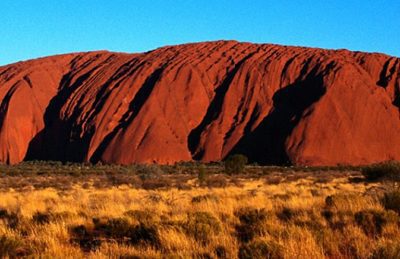ANCIENT SHORELINES

My fascination for the coast has always been a combination of an interest in present-day process and forms with the events and products of the past. This is seen as a mixture of coastal morphodynamics and coastal morphostratigraphy. Using the present as a key to the past is one thing, but the past can inform the present and even the future! So much of what we observe in relic coastal landforms and stratigraphic sections raises questions that we must try to answer even though for much of the time we are forced to use our imagination given the removal or burial of the record.
Two weeks ago I had the pleasure of visiting Alice Springs and Uluru for the first time. It is a long way from the sea, or is it? I made myself aware of some geological and geomorphological literature, especially the works of past giants of arid land studies such as Jack Mabbutt and Rowl Twidale. Inselbergs, pediments, flared slopes, desert dunes, all featuring in the classic red centre setting, provided me with a reminder of the vastness and majesty of our continent. But I could not forget two vastly different marine episodes that help mould interior Australia. The most recent occurred in the Cretaceous with its extensive marine transgression. Much older and ironically for this trip more obvious were the marine episodes accompanying the depositional sequences of the Amadeus Basin.
The Amadeus Basin is a well-studied sedimentary basin of early to mid-Palaeozoic age that trends east-west across the southern part of Northern Territory into WA. Its strata have been modified structurally by tectonic events including those around Uluru. Amadeus Basin is about 14 km thick and contains many thick sandstone units as well as units rich in oil and gas such as the Palm Valley gas field. At Kings Canyon, I met large outcrops of the Mereenie Formation of Silurian/Devonian age composed of silica sand. These sands were beautifully stratified and the bedding could be easily interpreted as beach extending upwards into dunes. The ripple marks preserved on slabs were symmetrical in section. Here I was over 1000km from the present coast and in a world of 400m years ago prompting thinking of coastal dynamics!
As a postgraduate student at LSU there was a very inspiring lecturer/professor by the name of John Ferm. He was a specialist in Palaeozoic sedimentology working on Carboniferous sequences in Kentucky and West Virginia. The group I was associated with at LSU, while focussing on so-called Recent sediments, were very conscious of the way their work may assist in the interpretation of ancient deposits rich in oil or coal. Ferm was a coal man. But he pushed me and others to think of the relation between ancient sequences and modern processes and deposits. His work involved looking at stratified sediments that he considered to be nearshore, beachface and tidal inlet. He made the past come alive.
The Sydney Basin is also rich in lithified sediments with clear evidence of past processes; the Hawkesbury Sandstone in particular has truncated sand wave stratification that points to a massive fluvial system. The one place where I look for coastal deposits of Triassic age in this Basin is in western Sydney near Minchinbury. Here we find calcareous sands that are part of the Wianamatta Formation that reflect ancient shorelines. Such calcareous deposits are common in ancient Pleistocene and late Tertiary shores that occur in parts of South Australia-Victoria and Western Australia although in both areas the more landward deposits tend to be siliceous and locally rich in heavy minerals. Working with Peter Roy and Cheng Ly in NSW, and some mining companies, I became familiar with the way heavy mineral seams had become imbedded into beachface and dune sands of late Pleistocene and mid Holocene age.
Ancient shoreline sequences have long attracted geologists. In recent decades there has been a coming together of those interested in the Quaternary and present-day processes with those who have explored old rocks. This interaction continues to be an area of research interest to many and for me personally something I cannot escape even when heading off to Alice Springs.
Words by Prof Bruce Thom. Please respect Bruce Thom’s thoughts and reference where appropriately: (c) ACS, 2016, posted 18th July 2016, for correspondence about this blog post please email admin@australiancoastalsociety.org.


